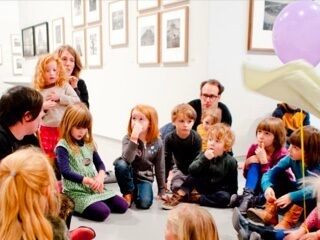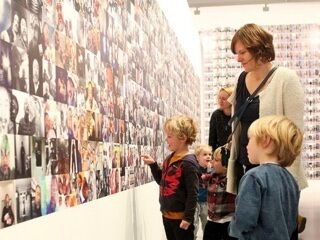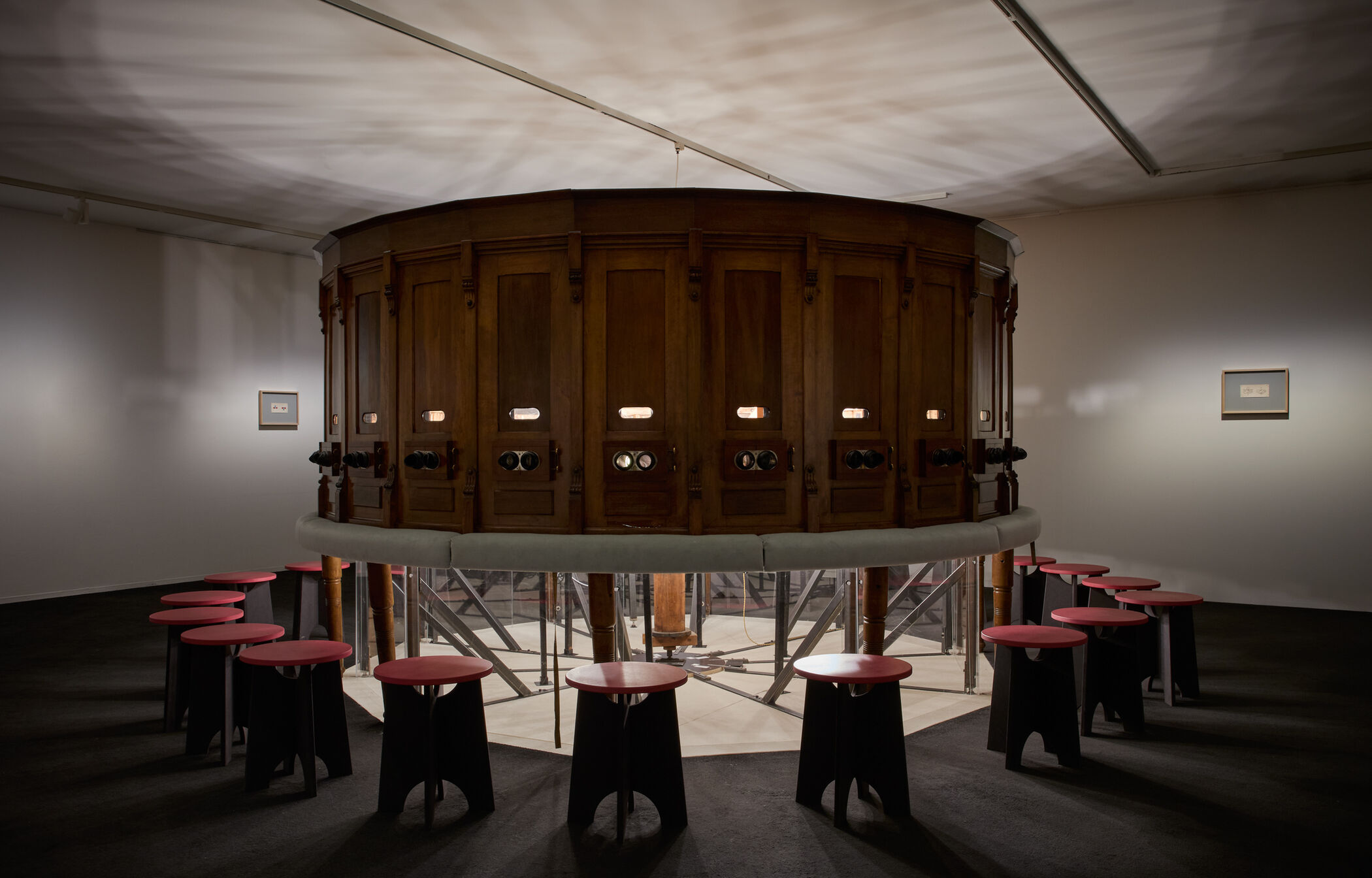Research projects
THE KAISERPANORAMA
The FOMU Kaiserpanorama is a remarkable collection item with an interesting history. In collaboration with researcher Leen Engelen (B-magic, Univerity of Antwerp), extensive research and restorations have been carried out in recent years, allowing the panorama to be shown in all its glory again. The carrousel had begun to grind as it turned, and the stereoscopic images were no longer nicely aligned with the viewers. The viewers themselves were in poor condition and the varnish on the panels had worn off in several places. One major alteration was to make the carrousel rotate separately from the old wooden structure in order to preserve the original material for as long as possible. We want everyone to be able to experience the spectacle and magic of the Kaiserpanorama.

THE GEVAERT PAPER PROJECT
The Gevaert Paper Project is aimed at unlocking the photographic paper and documentation, photo packaging and sample books in the collection of Agfa-Gevaert. We aim to make these materials and the related information accessible by means of a Wikibase. Together with digital heritage expert meemoo, we want to link the newly registered information to the collection of photo packaging and sample books already at FOMU. We thus want to create the first reference collection of that scale and diversity in Europe. This will also open up possibilities for international collaboration with similar collections in other parts of the world. With the support of the Flemish government the museum can conduct this research throughout 2020-2023.

PROJECT TEGENLICHT: NEW TECHNIQUES FOR PRESERVATION OF PHOTO ARCHIVES
How do you make important archives accessible, when the material and the volume of photographic film are so challenging?, Many archives and museums are currently wrestling with this question. This led to FOMU, ADVN (the archive for national movements) and KOERS (museum of cycle racing) joining forces to launch Tegenlicht (meaning backlight in Dutch). Tegenlicht is a Flemish government project aimed at catching up with the backlog in digital collection registration.

IEDEREEN BENOEMD/T
The FOMU has collections numbering over 3,000,000 items. 92% of these consist of such large volumes of material that it is impossible for our staff to evaluate each one individually. With an eye to improving the visibility, findability and usefulness of the items in its collections, the FOMU continually seeks out innovative tools with which to address the difficulties of registration. Now, with Iedereen Benoemd/t, we are asking you to help us register our collections. As our first Iedereen Benoemd/t project we have selected the Louis Artus collection, which consists of images he created during the filming of classic children’s tv series.

CONSERVATION & RESTORATION
Photo preservation is a recent discipline that involves a variety of materials with their own characteristic properties. Moreover, photography is still in full development, which makes the preservation and management of photographs, both analogue and digital, complex and raises a number of issues. Through its own research, publications, recommendations and workshops, the FOMU’s restoration studio wants to disseminate its expertise and make it available to the public.
One of the restoration studio’s core tasks is extending and guaranteeing the collection’s quality and longevity. Carefully controlling light, air quality, humidity and temperature significantly reduce the number of risks. With the Lieven Gevaert Tower, a modern climate-friendly depot named after the Flemish pioneer of the photographic industry, the FOMU built the first low-energy depot for photography in Europe. In this way, the growing collection can be preserved in a sustainable manner.

DIRECTORY OF BELGIAN PHOTOGRAPHERS
The Directory of Belgian Photographers is an extensive online database with information about Belgian photographers who were active in Belgium between the birth of photography in 1839 and Belgium’s 75th anniversary in 1905. The database currently contains 5,400 records and is the extensive and corrected online version of the Directory of Photographers in Belgium 1839-1905, compiled by Steven F. Joseph, Tristan Schwilden and Marie-Christine Claes, and published by the FOMU in 1997. The same authors were actively involved in the first online edition.
The FOMU wants to further expand the database with information about Belgian photographers from 1905 to the present day. The ultimate goal is to offer an online database about Belgian photographers or photographers who were active in Belgium that is as complete as possible. That is why we will systematically update and improve the database, not only with text, but also with images.

IMAGE RECOGNITION FOR CULTURAL HERITAGE
During 2019-2020 FOMU executed a research project about automated image recognition as an alternative or addition to the manual description of cultural heritage objects. The size of the FOMU collection is enormous. It contains more than 3 million objects. Registering this cultural heritage is a very labor-intensive process. Artificial Intelligence (AI) offers powerful solutions for automated recognizing of objects, people and even emotions. In recent time this technology became online accessible for (cultural heritage) organizations through means of online visual recognition services (VRS, e.g.: Google vision, Clarifai, Microsoft Azure,…)
With the support of the Flemish government, a methodology was sought for tagging or categorizing images using these visual recognition services and integrating the results into the collections management software (e.g. Adlib and Memorix Maior). In order to get a good idea of the possibilities of this technology, four diverse pilot projects were developed by the content partners FOMU, Erfgoedcel Brugge, MoMu and Netwerk Oorlogsbronnen. FOMU also collaborated with digital heritage expert meemoo and technical coordinator Datable.
The final report is available to read online (in Dutch).

VALUATION
The FOMU applies the principle of value-based heritage management in its decision-making process regarding the preservation and safeguarding of the collection. That is why the FOMU has started a valuation process for its collection. Valuing the collection helps to gain a more detailed insight into the history, meaning and (development) potential of the collection. The results of a valuation process are used, for example, to give direction to the collection policy, but also to set priorities in terms of conservation, or to improve the emergency plan. The FOMU is also gaining expertise in the area of collection valuation based on separate projects.
For example, although the Agfa-Gevaert Historical Archives, which were donated to the FOMU in 2015, have a special significance to the FOMU, not all sub-collections ideally located for optimal access in the FOMU. On the basis of valuation, various sub-collections have since been relocated and specific actions are being taken for the other sub-collections.
Thanks to the financial support of the Flemish Community, the FOMU has investigated the problem of rating large collections of slide positives and negatives. In this context, a number of tools were tested for their employability in carrying out valuations, including the contact sheet method to digitise in bulk at low resolution and a condition assessment tool to quickly collect objective information about a collection.






